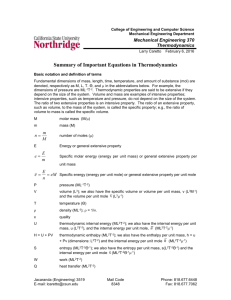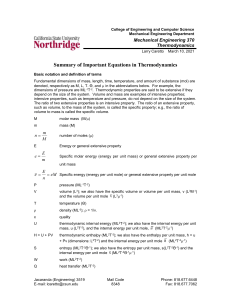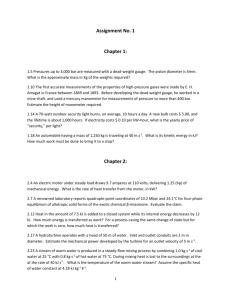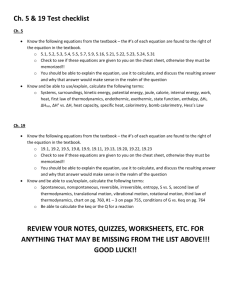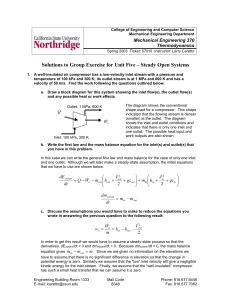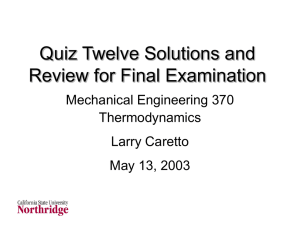Summary of equations used in thermodynamics
advertisement
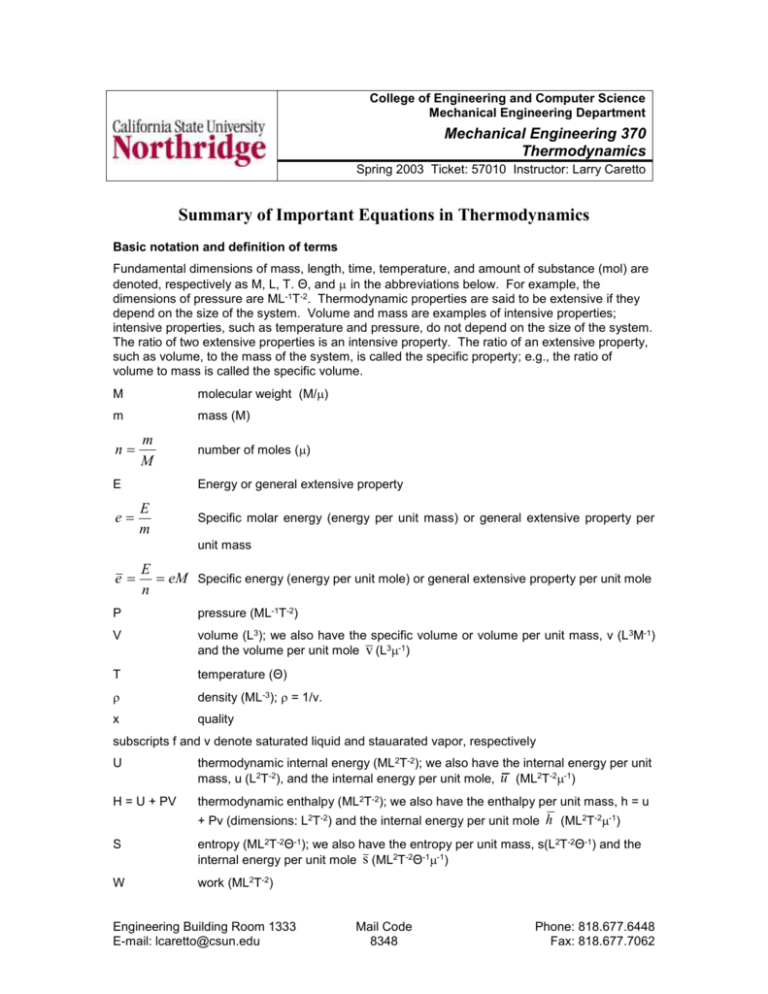
College of Engineering and Computer Science Mechanical Engineering Department Mechanical Engineering 370 Thermodynamics Spring 2003 Ticket: 57010 Instructor: Larry Caretto Summary of Important Equations in Thermodynamics Basic notation and definition of terms Fundamental dimensions of mass, length, time, temperature, and amount of substance (mol) are denoted, respectively as M, L, T. Θ, and in the abbreviations below. For example, the dimensions of pressure are ML-1T-2. Thermodynamic properties are said to be extensive if they depend on the size of the system. Volume and mass are examples of intensive properties; intensive properties, such as temperature and pressure, do not depend on the size of the system. The ratio of two extensive properties is an intensive property. The ratio of an extensive property, such as volume, to the mass of the system, is called the specific property; e.g., the ratio of volume to mass is called the specific volume. M molecular weight (M/) m mass (M) n m M E e number of moles () Energy or general extensive property E m Specific molar energy (energy per unit mass) or general extensive property per unit mass e E eM Specific energy (energy per unit mole) or general extensive property per unit mole n P pressure (ML-1T-2) V volume (L3); we also have the specific volume or volume per unit mass, v (L 3M-1) and the volume per unit mole v (L3-1) T temperature (Θ) density (ML-3); = 1/v. x quality subscripts f and v denote saturated liquid and stauarated vapor, respectively U thermodynamic internal energy (ML2T-2); we also have the internal energy per unit mass, u (L2T-2), and the internal energy per unit mole, u (ML2T-2-1) H = U + PV thermodynamic enthalpy (ML2T-2); we also have the enthalpy per unit mass, h = u + Pv (dimensions: L2T-2) and the internal energy per unit mole h (ML2T-2-1) S entropy (ML2T-2Θ-1); we also have the entropy per unit mass, s(L2T-2Θ-1) and the internal energy per unit mole s (ML2T-2Θ-1-1) W work (ML2T-2) Engineering Building Room 1333 E-mail: lcaretto@csun.edu Mail Code 8348 Phone: 818.677.6448 Fax: 818.677.7062 Equations of thermodynamics ME 370, L. S. Caretto, Spring 2003 Q heat transfer (ML2T-2) W u : the useful work rate or mechanical power (ML2T-3) : m V2 : 2 gz: Etot: Q : Page 2 the mass flow rate (MT-1) the kinetic energy per unit mass (L2T-2) the potential energy per unit mass (L2T-2) V2 the total energy = m(u + + gz) (ML2T-2) 2 the heat transfer rate (ML2T-3) dEcv 2 -3 dt : the rate of change of energy for the control volume. (ML T ) Mass and energy balance equations The equations below use the standard thermodynamic sign convention for heat and work. Heat added to a system is positive and heat rejected from a system is negative. The opposite convention holds for work. Work done by a system is positive; work done on (added to) a system is negative. In terms of the W in, W out, Qin, and Qout terms used in the text we can make the following statements. Q = Qin - Qout W = W out - W in These equations may be substituted for any of the heat, Q, or work, W terms below. Relation of mass flow to velocity, specific volume and area: VA m VA v dE cv Vi2 Vi2 m i hi i hi Q Wu m gz gz General first law: i i inlet dt 2 2 outlet Mass balance equation: dm cv i m i m dt inlet outlet Steady-flow assumptions: Steady-flow first law: Mass balance for steady flows: dEcv dt = 0 and dmcv dt = 0 2 2 V V i Q m i hi i h i i gz i W m gz u i inlet 2 2 outlet m inlet i m i outlet Steady-flow first law with negligible KE & PE: Q W u m h m h i outlet i i inlet i Equations of thermodynamics ME 370, L. S. Caretto, Spring 2003 Page 3 Second law of thermodynamics and entropy Basic definition of entropy: dS dU PdV T General second law: dScv Q LW cv isi m i s i cv m dt T T outlet inlet Second law inequality: dScv Q isi m i s i cv m dt T outlet inlet Adiabatic steady-flow, second law inequality: m s m s i i outlet i i 0 inlet Ideal-gas equations 1. The gas constant R is the universal gas constant with dimensions of energy divided by (moles times R temperature), and R is the engineering gas constant with dimensions of energy divided M by (mass times temperature). The energy dimensions are sometimes expressed as energy units (e.g., J). However, for P-v-T calculations, the energy dimensions are expressed in pressure units times volume units (e.g., kPa•m 3. Some values of the universal gas constant are shown below. 8.314 kJ 8.314 kPa m 3 1545.35 ft lb f 10.7316 psia ft 3 R kmol K kmol K lbmol R lbmol R 2. P-V-T calculations with mass or moles. The example in the first equation is air (R = 0.287 kJ/kg-K). Both examples are for an ideal gas that occupies a volume of 1 m 3 at a pressure of 100 kPa and a temperature of 25 C = 298.15 K. PV m = RT = n= 3. (100 kPa) (1 m3) 1 kJ kPa-m3 kJ 0.287 kg-K 298.15 K = 1.169 kg PV (100 kPa )(1 m 3 ) = = 0.04034 kmol RT 8.314 kPa m 3 (298.15 K ) kmol K Heat capacity definitions and relations and computations of internal energy and enthalpy changes a. Basic rule: for ideal gases, the internal energy, enthalpy, and heat capacities are functions of temperature only. b. Heat capacity definition and relations Equations of thermodynamics ME 370, L. S. Caretto, Spring 2003 H CP T P U Cv T v h C c P P Mc P n T P C u c v v Mc v n T v C c h cP P P m M T P C c u cv v v T v m M Cp – Cv = mR = n R c. Page 4 cp – cv = R cP cv R Relationships for internal energy and enthalpy T2 du = cvdT dh = cpdT u2 – u1 = c T2 v h2 – h1 = dT T1 For constant heat capacity: u2 – u1 = cv(T2 – T1) From ideal gas tables: u2 – u1 = uo(T2) – uo(T1) 4. and and constant heat capacity variable heat capacity by integration T2 T2 P2 v2 dT dT s2 - s1 = cp T - R ln P = cv T + R ln v 1 1 T1 T1 c. variable heat capacity by ideal gas tables P2 s2 - s1 = so(T2) - so(T1) - R ln P 1 5. End states of an isentropic process for an ideal gas with a. constant heat capacity (k = cp/cv) P2 (k-1) /k T2 = T1P 1 b. v1 k P2 = P1v 2 variable heat capacity using the air tables Pr(T2) P2 Pr(T1) = P1 c. v1 (k-1) T2 = T1v 2 dT h2 – h1 = ho(T2) – ho(T1) T2 P2 T2 v2 s2 - s1 = cp ln T - R ln P = cv ln T - R ln v 1 1 1 1 b. P h2 – h1 = cP(T2 – T1) Entropy changes a. c T1 vr(T2) v2 vr(T1) = v1 variable heat capacity using general ideal gas tables Equations of thermodynamics ME 370, L. S. Caretto, Spring 2003 Page 5 P2 so(T2) = so(T1) - R ln P 1 d. variable heat capacity by integration of cp(T) or cv(T) equation T2 P cp dT = R ln 2 T P1 T1 T2 v cv dT = R ln 2 T v1 or T1 Cycles and efficiencies In an engine cycle a certain amount of heat, |QH|, is added to the cyclic device at a high temperature and a certain amount of work |W| is performed by the device. The difference between |QH| and |W| is |QL|, the heat rejected from the device at a low temperature. In a refrigeration cycle a certain amount of heat, |QL|, is added to the cyclic device at a low temperature and a certain amount of work |W| is performed on the device. The sum of |QL| and |W| is |QH|, the heat rejected from the device at a high temperature. For both devices: Engine cycle efficiency: Refrigeration cycle coefficient of performance: |QH| = |W| + |QL| |W| | QH | COP QL W The isentropic efficiency, s, compares the actual work, |wa|, to the ideal work that would be done in an isentropic (reversible adiabatic) process, |ws|. Both the actual and the isentropic process have the same initial states and the same final pressure. For a work output device: s | wa | | ws | For a work input device: s | ws | | wa |
